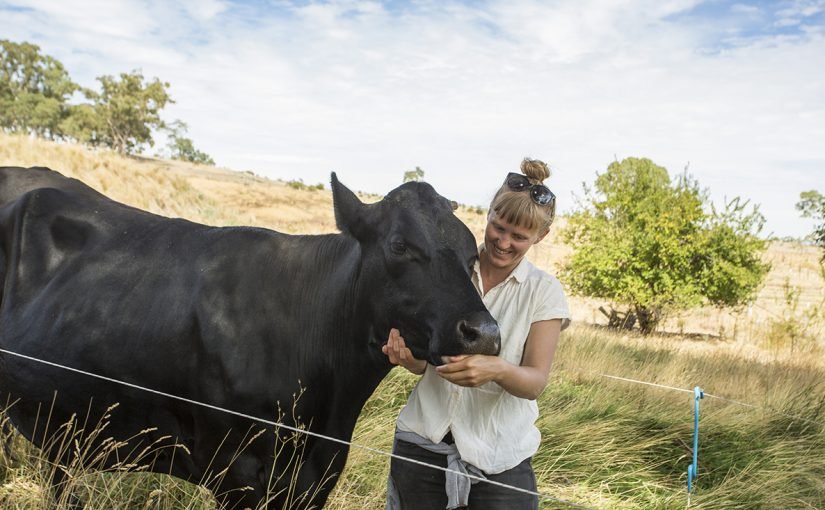Berta the cow really holds a very special place in our hearts. She was the first cow we bought and showed us just how amazing a good cow can be. She was also the first cow I had calve, she sailed through it like a pro and Iggy was born. We had naively planned to have the rest of the dairy up and running by the time she calved 21 months ago so it was unknown to me at the time that I would spend the next 18 months making cheese at home every night and we would have to keep to a strict daily cheese consumption quota.
I’m reflecting on this now as Berta is due to calve again this weekend. Her 8th calf, another Dairy Shorthorn, this time no night cheesemaking and I can actually sell her delicious milk!

Everyone on the farm is working like the dream team, milking is a breeze and with this amazing rain we’ve had I’m feeling great about the season. As Berta gets closer though I’m having more sleepless nights with worry. During her last lactation, one week after Oli’s accident when he lost a finger, Berta got mastitis. It was a very dark time for me, I had many moments of questioning if I was cut out for dairy farming.
Two factors lead to Berta’s mastitis. Firstly my mismanagement of the calves. It was my first lesson in always prioritising the cows health above all others. As she was feeding 2 calves and they had become boisterous in their feeding she had developed a bad cut on her teat. As soon as this happened I should have weaned the calves off her straight away, even if this meant extra time feeding calves and me having to milk twice a day and make more cheese. In the long run this still would have taken less time. I didn’t wean them though, and because of these cuts she contracted mastitis. She made an amazing recovery but it has left her udder in the high risk category for future mastitis particularly in the first few months after calving when she’s producing so much milk.
The second factor is her breeding. Berta is a high production cow, we’re talking 43ltrs a day at peak. She’s a big black bitsa, probably mainly Friesian. This has been a big influence on me to move away from these high production breeds. There is a reason the average dairy cow only makes it to 5 years old; when you breed an animal to be so productive in one form it leaves them vulnerable in others. Dairy animals are very vulnerable when compared to an animal breed for meat. A local Dairy Shorthorn farmer explained to me how before the war and the beginning of industrial agriculture, most farmers favoured dual purpose breeds such as the Shorthorn as small farms had to be financial resilience and this was only possible through making an income off all elements of the business; growing out the male calves for meat was a key part of this. So yes, many of these older breeds produce less butter fat than a jersey and less litres than a Friesian/Holstein, but with that comes a more resilient animal from what I’ve seen. Obviously within this every animal is an individual with there own weaknesses and then the way they are managed has a huge impact on their health and strength. However as we have seen with all heritage breeds vs single purpose breeds, whether it’s egg birds or meat birds, high production meat animals and dairy animals, when you breed for one particular trait you leave other traits lacking. The way they are managed over generations also impacts how they respond to conditions. So many of these older breeds will do well on what many would call ‘poorer’ quality feed. I question this ‘poorer’ as many of the dairy breeds respond better to high protein feeds and grain however cows as a species have evolved as grazers and the only grain they would naturally be eating is seed heads on grasses, not kilos at a time. So living in Central Victoria where the pastures are far from ‘high quality’, I need to be looking towards animals who do better on the feed we can grow. After calving, my Shorthorns haven’t skipped a beat and have stayed in beautiful condition, the Jersey and Berta however are much harder to keep condition on as they priorities their energy for milk production, sacrificing themselves.

So I’m feeling a little melancholy about Berta calving this time round. Will she get sick again due to past damage? Will I be able to keep her in such good condition that she will have the strength to fight for herself. In organic farming this is how you manage health, rather than fighting illness yourself, you are equipping the animal with everything you can to fight herself. I’m also feeling guilt, that our industry/culture/society has chased this cheap commodity food to a point where we have created super animals who are such a high risk to themselves. That’s really at the core of animal cruelty to me.
Learning is hard when working within animal systems. It often happens at the expense of an animal, so the key is to never make the mistake twice and to learn from others mistakes and knowledge as much as you possibly can.
So I watch with eagle eyes. This cow has brought me so much joy and wisdom, I hope to be able to do my best to ensure her health, minimal pain and treat her with the greatest respect for, hopefully, many years to come, even if this may be her last calving and she gets to retire.


Leave a Reply